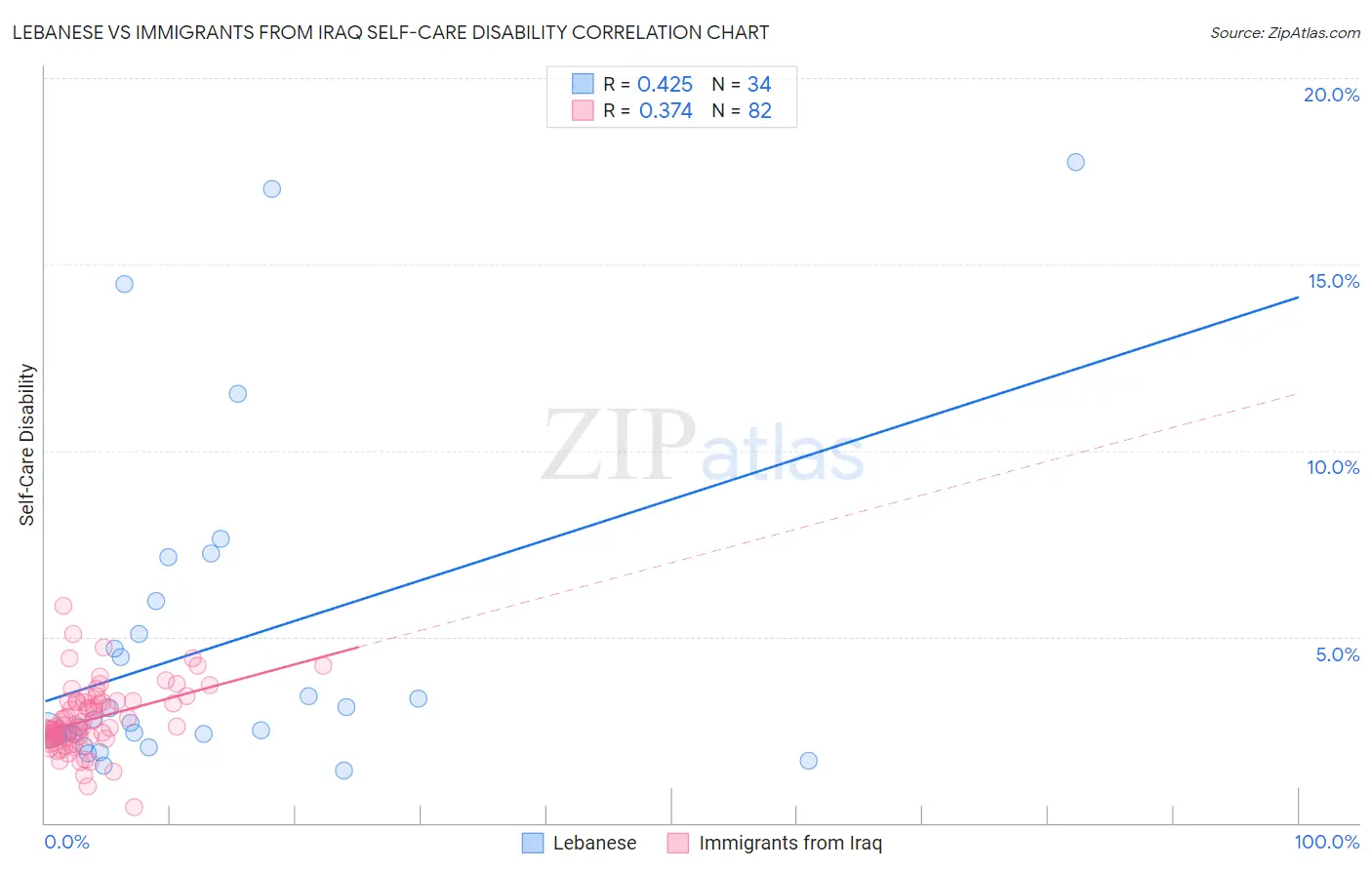Lebanese vs Immigrants from Iraq Self-Care Disability
COMPARE
Lebanese
Immigrants from Iraq
Self-Care Disability
Self-Care Disability Comparison
Lebanese
Immigrants from Iraq
2.4%
SELF-CARE DISABILITY
66.5/ 100
METRIC RATING
161st/ 347
METRIC RANK
2.7%
SELF-CARE DISABILITY
0.0/ 100
METRIC RATING
281st/ 347
METRIC RANK
Lebanese vs Immigrants from Iraq Self-Care Disability Correlation Chart
The statistical analysis conducted on geographies consisting of 401,146,528 people shows a moderate positive correlation between the proportion of Lebanese and percentage of population with self-care disability in the United States with a correlation coefficient (R) of 0.425 and weighted average of 2.4%. Similarly, the statistical analysis conducted on geographies consisting of 194,657,013 people shows a mild positive correlation between the proportion of Immigrants from Iraq and percentage of population with self-care disability in the United States with a correlation coefficient (R) of 0.374 and weighted average of 2.7%, a difference of 10.1%.

Self-Care Disability Correlation Summary
| Measurement | Lebanese | Immigrants from Iraq |
| Minimum | 1.4% | 0.43% |
| Maximum | 17.8% | 5.8% |
| Range | 16.4% | 5.4% |
| Mean | 4.6% | 2.8% |
| Median | 2.6% | 2.6% |
| Interquartile 25% (IQ1) | 2.3% | 2.3% |
| Interquartile 75% (IQ3) | 5.1% | 3.3% |
| Interquartile Range (IQR) | 2.7% | 1.0% |
| Standard Deviation (Sample) | 4.3% | 0.89% |
| Standard Deviation (Population) | 4.3% | 0.89% |
Similar Demographics by Self-Care Disability
Demographics Similar to Lebanese by Self-Care Disability
In terms of self-care disability, the demographic groups most similar to Lebanese are Finnish (2.4%, a difference of 0.030%), Immigrants from Western Europe (2.4%, a difference of 0.11%), Immigrants from Italy (2.4%, a difference of 0.11%), Somali (2.5%, a difference of 0.14%), and Immigrants from Europe (2.4%, a difference of 0.17%).
| Demographics | Rating | Rank | Self-Care Disability |
| Italians | 72.2 /100 | #154 | Good 2.4% |
| Pakistanis | 71.4 /100 | #155 | Good 2.4% |
| Nigerians | 70.6 /100 | #156 | Good 2.4% |
| Immigrants | Europe | 69.6 /100 | #157 | Good 2.4% |
| Immigrants | Western Europe | 68.6 /100 | #158 | Good 2.4% |
| Immigrants | Italy | 68.5 /100 | #159 | Good 2.4% |
| Finns | 67.0 /100 | #160 | Good 2.4% |
| Lebanese | 66.5 /100 | #161 | Good 2.4% |
| Somalis | 63.7 /100 | #162 | Good 2.5% |
| German Russians | 62.7 /100 | #163 | Good 2.5% |
| Immigrants | Vietnam | 59.3 /100 | #164 | Average 2.5% |
| Syrians | 59.0 /100 | #165 | Average 2.5% |
| Canadians | 58.8 /100 | #166 | Average 2.5% |
| Immigrants | Greece | 57.3 /100 | #167 | Average 2.5% |
| Ute | 57.1 /100 | #168 | Average 2.5% |
Demographics Similar to Immigrants from Iraq by Self-Care Disability
In terms of self-care disability, the demographic groups most similar to Immigrants from Iraq are Apache (2.7%, a difference of 0.020%), Delaware (2.7%, a difference of 0.090%), Fijian (2.7%, a difference of 0.13%), Hispanic or Latino (2.7%, a difference of 0.16%), and Jamaican (2.7%, a difference of 0.17%).
| Demographics | Rating | Rank | Self-Care Disability |
| Yakama | 0.1 /100 | #274 | Tragic 2.7% |
| Immigrants | Trinidad and Tobago | 0.1 /100 | #275 | Tragic 2.7% |
| Japanese | 0.1 /100 | #276 | Tragic 2.7% |
| Immigrants | Ukraine | 0.1 /100 | #277 | Tragic 2.7% |
| Ottawa | 0.1 /100 | #278 | Tragic 2.7% |
| Iroquois | 0.1 /100 | #279 | Tragic 2.7% |
| Hispanics or Latinos | 0.1 /100 | #280 | Tragic 2.7% |
| Immigrants | Iraq | 0.0 /100 | #281 | Tragic 2.7% |
| Apache | 0.0 /100 | #282 | Tragic 2.7% |
| Delaware | 0.0 /100 | #283 | Tragic 2.7% |
| Fijians | 0.0 /100 | #284 | Tragic 2.7% |
| Jamaicans | 0.0 /100 | #285 | Tragic 2.7% |
| French American Indians | 0.0 /100 | #286 | Tragic 2.7% |
| Immigrants | Jamaica | 0.0 /100 | #287 | Tragic 2.7% |
| Immigrants | Barbados | 0.0 /100 | #288 | Tragic 2.7% |